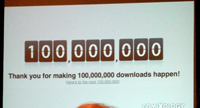
Although Days 3 and 4 (Saturday and Sunday) of New York Comic-Con are designed for fans (Saturday normally features some star panels and screenings, and Sunday is the day for kids and families), I found interesting and engaging professional panels this weekend. This was a good thing, since getting into some of the star sessions—such as a panel discussion on the 10th anniversary of the TV show Firefly—was not going to happen!
ComiXology: Digital comics
 One of the newest tools for comics is ComiXology, a web and app tool for downloading and reading comics, print comics in digital form, and born digital or transmedia comics. ComiXology was founded in 2007 by David Steinberger, John Roberts, and Peter Jaffe not as a content consumption platform but as a way to catalog comic collections. After hearing the fear comics publishers had of the new digital world, Steinberger and his team thought they could find a way to bridge that gap.
One of the newest tools for comics is ComiXology, a web and app tool for downloading and reading comics, print comics in digital form, and born digital or transmedia comics. ComiXology was founded in 2007 by David Steinberger, John Roberts, and Peter Jaffe not as a content consumption platform but as a way to catalog comic collections. After hearing the fear comics publishers had of the new digital world, Steinberger and his team thought they could find a way to bridge that gap.
Their first website was solely devoted to ordering print comics, and two years later they developed their first app for the iOS platform (iPhone and iPod) for consuming content. In 2010, the tool saw continued mobile expansion (the iPad and Android apps were released this year) and branded apps with Marvel and DC Comics.
Last year, ComiXology was preloaded on the Kindle Fire, and the Windows 8 app is currently in development for release later this year. Other projects include Comics 4 Kids (an app for children that links with the main ComiXology account), ComiXology Submit (a pipeline for authors to get their content into the app), and expanded catalogs.
Why should libraries know about ComiXology? It is an app being used by millions of library users (actual and potential), which may mean that patrons will want to know if they can use it for library lending, just like OverDrive enables them to borrow Kindle books from participating libraries. However, there is no library model for ComiXology in development. (It should also be noted, that there is a iVerse Media has a comic library-lending model in beta testing stage.) Steinberger is viewing the library landscape and finding ways to incorporate libraries into ComiXology’s business plan, but he is also taking lessons from the struggle between librarians and publishers over ebooks. If there isn’t a happy medium between publishers and libraries for ebooks, what does that mean for a medium that is still new to libraries in print form? Perhaps digital comics provides librarians an opportunity to start the conversation with publishers and articulate libraries’ needs to stakeholders from the start.
You can follow ComiXology on Twitter, along with its blog, for its latest developments. I’ve been using the ComiXology app for several months now, and aside from difficulties downloading one graphic novel, I have been very pleased with its usability. The comics look great on my iPad, no doubt because of recent iOS6 upgrades on the iOS platform. In-app purchases are seamless, just like any other in-app purchase—similar to the ease of obtaining a Kindle book directly from the device. Having noted the relative ease of using Kindle for Libraries with my own local library, I hope that some sort of library model for ComiXology comes to fruition sooner rather than later.
The fight to defend manga
 The Comic Book Legal Defense Fund featured two panels devoted to manga, the Japanese comic form that rose to worldwide attention in the late 20th century. Like its sister format of anime, manga often features very adult content—violence, nudity, and sexuality—which comes from very different taboos on these social issues in that country, and relaxation of censorship rules in Japan during the 1990s. This misunderstanding, coupled with the longstanding taboos against comics and the popularity of manga, have led to high-profile court cases.
The Comic Book Legal Defense Fund featured two panels devoted to manga, the Japanese comic form that rose to worldwide attention in the late 20th century. Like its sister format of anime, manga often features very adult content—violence, nudity, and sexuality—which comes from very different taboos on these social issues in that country, and relaxation of censorship rules in Japan during the 1990s. This misunderstanding, coupled with the longstanding taboos against comics and the popularity of manga, have led to high-profile court cases.
The first high-profile prosecution related to manga came in 2000 in the case of Texas v. Castillo, when a clerk was convicted for selling manga. The content was in the adult section of the store and clearly labeled “Not for Children.” Although the prosecution’s case was weak (hinging on the belief that all comics are for children rather than adults), Castillo was convicted. (He ultimately served just probation.)
In 2003, the PROTECT Act put stronger controls on what is and is not obscene content. The law offered stronger punishment for child sexual abuse crimes, but it gave rise to virtual obscenity materials, allowing for conviction based on content of a visual depiction of sexual acts, putting expressive art on par with evidence of a crime. This means that manga can be easily misinterpreted as child pornography because its styles often feature adults in a diminutive form that looks like children (but are not). This exact situation happened in 2010, when Minnesota computer programmer Ryan Matheson, while traveling to visit a friend in Canada, was stopped at the border and arrested for possessing pornographic content.
Matheson was a model citizen with no criminal record, but was unlawfully detained for more than four hours while Canadian customs searched his computer and other electronics. The image that led to his arrest was a popular image called “The 48 Positions: Moe Style.” The depictions in the drawings are diminutive figures, which could be easily (and incorrectly) interpreted by non-manga fans as obscene.
Once Matheson was released several days later from detention, he was allowed to use computers at only one specific company: his place of work at the time. When he lost that job, he had to appear in person in court to get the restrictions relaxed to allow computer use for work purposes. All this took time, money, and an emotional toll on Matheson and his family.
With the help of the Comic Book Legal Defense Fund and its Canadian counterpart, the Comic Legends Legal Defense Fund, Matheson’s defense provided expert testimony on the artistic merit of manga and its protections under the First Amendment, which enabled all charges against him to be dropped later this year. This was the first major victory for readers’ rights.
But challenges to these rights persist. Some customs and law officials, particularly in Canada, still believe that manga is equivalent to child pornography. This leads to limits on business for creators and artists, fears from academics that their studies on Japanese culture (which can include library materials) can lead to an arrest, and fears from readers that their hobby (which can also include use of library materials) can destroy their lives. The library has an obligation to protect the right to read and the right to information, and awareness of cases such as these make our intellectual freedom arsenal all that stronger.
You can read Matheson’s personal statement on the case on the CBLDF blog, and sci-fi website i09 also has great coverage of his story.
One final note: CBLDF will be releasing a best practices guide for manga, geared for parents, teachers, and librarians in spring 2013, close to the time of the ALA Annual Conference in Chicago. Check the CBLDF blog for further developments.
And that’s a wrap!
It’s been an amazing experience (as it was last year) to attend New York Comic-Con as a professional, a fan, and for the first time this year, as a reporter. I am extremely grateful for the opportunity to cover it for American Libraries, and wish to thank all at ALA that made this possible. New York Comic-Con will take place next year on October 10–13, 2013.
KATE KOSTURSKI received her MLS from Pratt Institute and is currently the institutional participation coordinator (UK and Northern Europe) for JSTOR. She is a member of ALA’s GameRT. Visit her at katekosturski.com, and follow her on Twitter at @librarian_kate.

